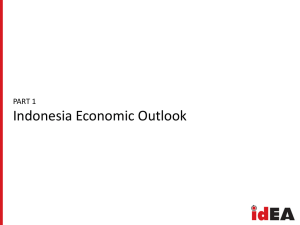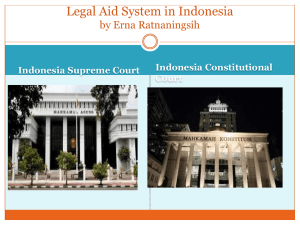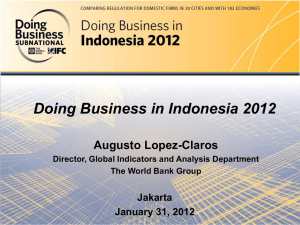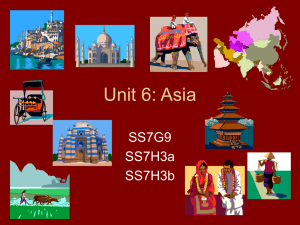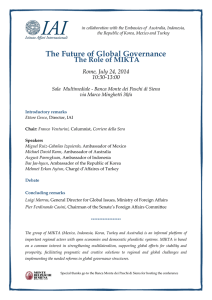Education Sector Profile- Indonesia
advertisement
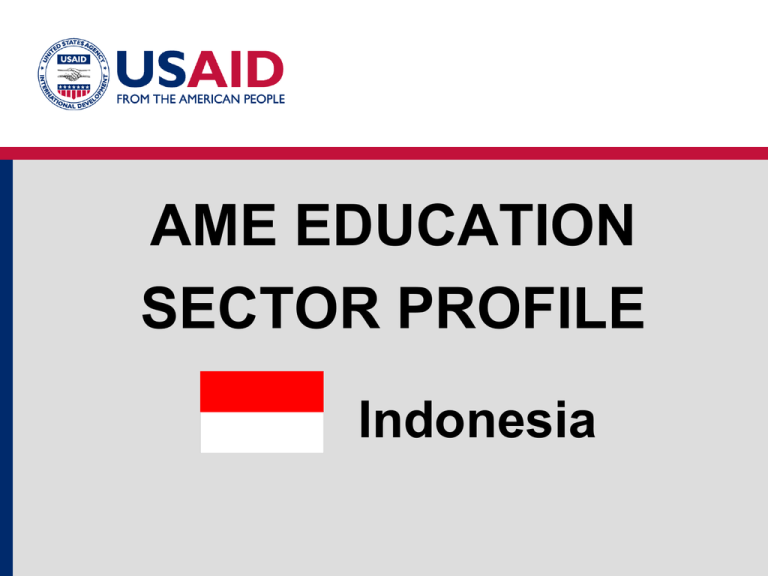
AME EDUCATION SECTOR PROFILE Indonesia Indonesia Education Structure Education System Structure and Gross Enrollments 2007 Source: World Bank EdStats, UNESCO Institute for Statistics Indonesia Education Structure • Compulsory education in Indonesia consists of grades 1-9. • 25% of children at primary level are over-age as indicated by the large gross enrollment percentage. % Net % Gross Enrollments Enrollments Education Configuration and Enrollments 2007 Classification Level/Grade Pre-primary Pre-school Ages 2007 2007 4-5 31% 44% 95% 117% 62%* 91% 42%* 57% N/A 13% N/A 18%** Primary, grades 1-6 7-12 Junior Secondary, grades Pre-university 7-9 13-15 Senior secondary, grades 10-12 16-18 Tertiary TVET Secondary 16-18 Post secondary TVET 19-22 2 year degree 19-20 4 year degree 18-22 *2005 data. ** Includes all degree levels of Tertiary. Source: World Bank EdStats, UNESCO Institute for Statistics . Indonesia Population Structure • 54% of the population is less than 30 years old. •Indonesia’s total population is the fourth largest in the world at 240,271,522. Population Structure: Indonesia (2008) 15-29 years 27% 0-14 years 27% 65+ years 6% Source: International Labor Organization 30-65 years 40% Indonesia Education Policy Relevant Policies: • National Education Strategic Plan 2005-2009 (RENSTRA) http://planipolis.iiep.unesco.org/upload/Indonesia/Indonesia%20EducationPlan2005-2009.pdf • National EFA Action Plan 2003/2015 http://planipolis.iiep.unesco.org/upload/Indonesia/Indonesia_EFA_MDA.pdf • Inclusive Education: The Way of the Future 2008 http://www.ibe.unesco.org/National_Reports/ICE_2008/indonesia_NR08.pdf Indonesia Education Access: Pre-university • Primary enrollments have declined incrementally • Secondary enrollments are growing strongly, more than 28% since 1990. Pre-university Enrollment Rates 120.0% 1990 Enrollments (%) 100.0% 2007 80.0% 60.0% • Pre- primary, lower and upper secondary: gross enrollments from 2000. 40.0% 20.0% 0.0% Pre-primary* Primary Lower Secondary* Upper Secondary* Source: World Bank EdStats, Indonesia Ministry of National Education Total Secondary Indonesia Education Access: Tertiary • Every year, 450,000 students take the national university entrance exam to compete for 75,000 seats at public universities. • Private universities enroll more than double the number of students who enroll in public universities. Post-Secondary Gross Enrollments Number of Students (000) 3500 Public Private 3000 Total 2500 2000 1500 *Public/ 1000 private data not available for 2006. 500 0 1990 2000 Source: World Development Indicators, UNESCO 2006 2003 2006 Indonesia Education Access: Gender •At the secondary level, the gender gap has closed as a result of girls and boys enrolling in equal numbers. • The Gender Parity Index for combined primary and secondary levels (gross enrollment) is .98. Percentagbe Enrollments 100.0% Pre-university Net Enrollments by Gender 80.0% 60.0% 40.0% 20.0% 1990 2000 Primary Boys Primary Girls Source: World Bank EdStats 2004 Secondary Boys 2007 Secondary Girls Indonesia Education Quality: Teachers • 63% of teachers have less than a four-year post-secondary education the government stipulates as a minimum teaching qualification. • 81% of teachers with the lowest levels of education themselves teach at the primary level of education. Teacher Academic Qualifications (2005) 1 year 4% 2 year 26% 3 year 7% Sr Sec. 26% Master 0% Source: Indonesia Ministry of National Education 2008 Bachelor 37% Indonesia Education Quality: Teachers • 66% of remote primary schools do not have enough teachers. • 68% of urban primary schools have too many teachers. Over/under Supply of Primary Teachers by Location 2005 80 60 68 55 52 Supply (%) 40 17 20 0 -20 Total Urban Rural Remote -21 -40 -34 -37 -60 -66 -80 Over-supply Source: Employment and Deployment Survey 2005 Under-supply Indonesia Education Quality: Completion • Indonesian children are very successful at completing primary education, in the past girls more so than boys. Primary Completion Rates Percentage Completion 108 106 104 102 100 98 96 94 92 90 88 1995 2001 Boys Source: World Bank EdStats 2004 Girls Total 2007 Indonesia Education Quality: Testing • Indonesia grade 8 students placed 34 out of 45 participating countries on the 2003 TIMSS and 36 out of 49 on the 2007 TIMSS. • On the 2007math test, 29% of students did not attain the lowest benchmark score of 400 and 48% achieved the low benchmark score. Grade 8 Student Performance TIMSS Math 2007 Percentage Attainment 60% 50% Math 40% 30% 20% 10% 0% Below low (<400) Low (400) Intermed-iate (475) Scoring Benchmarks Source: TIMSS 2007 International Math Report High (550) Advanced (625) Indonesia Education Equity: Geographic Disparities • The diverse and wide variation in geographic and population distribution patterns of Indonesia challenge national education reform planning and implementation. • For example, in 2004, net enrollment rates in primary education ranged from approximately 80% in the province of Papua to about 95% in Kalimantan Tengah. • At the junior secondary level, net enrollment rates varied from about 41% in Papua to approximately 77% in D.I Yogyakarta, and at the senior secondary level, from around 20% in Sulawesi Barat to approximately 62% in D.I. Yogyakarta. • The system must also be responsive to the religious and cultural diversity in the country, acknowledging many faiths and ethnicities of the population. Source: EFA Mid Decade Assessment Indonesia 2007 Indonesia Education Equity: Income Disparities • Primary enrollment is almost universal across wealth quintiles. • The poorest students have little access to university education. Enrollments by Income Quintile and Level (2003) 120 Enrollment (%) 100 80 Primary 60 Jr Secondary 40 Sr Secondary University 20 0 Poorest Q Q2 Source: Triaswati and Roesian 2003 Q3 Q4 Richest Q Indonesia Education Equity: Academic Disparities • Pre-primary education is largely provided by private entities. • A large proportion of technical-vocational education is offered privately but recent research questions quality of education offered at these institutions. Private Share of Education Provision Enrollment Percentage 120 100 80 60 40 20 0 2000 Pre-primary Sr. Secondary Source: UNESCO Institute for Statistics 2002 2004 Primary TVET Secondary 2007 Jr. Secondary Indonesia Education Efficiency: Expenditure • Education share of GDP has increased from 2.5% to 3.9% and share of public expenditure has risen from 12% to 16.8% since 2000. Public Spending on Education in SE Asia % (Most recent year 2000-2005) OECD % Public Spending % GDP ASEAN Bangladesh Laos Indonesia India Cambodia Thailand Philippines 0.0% 5.0% 10.0% 15.0% 20.0% Source: World Bank Education at a Glance, Global Monitoring Report 2008 25.0% 30.0% Indonesia Education Efficiency: Expenditure • The large expenditures on primary education have paid off in almost universal enrollments at that level. Education Spending Pattern 2005 Jr Secondary 27% Primary 46% Tertiary 12% Source: World Bank 2007 Investing in Indonesia’ s Education Sr Secondary 15% Indonesia Education Efficiency: Repetition • Apparently, primary repetition rates have been a target of the government in the past and are now quite low. • Repetition appears to be no issue at the secondary level. Primary and Secondary Repetition Rates 7 REpetition (%) 6 Primary 5 Secondary 4 3 2 1 0 2000 Source: UNESCO Institute for Statistics 2002 2004 2007 Indonesia Education Efficiency: Repetition • Indonesia compares favorably with other ASEAN countries with similar spending rates to address repetition at the primary level. 14 Public Spending on education and primary repetition rates ASEAN (most recent year 2000-2006) Percentages 12 %GDP 10 8 6 4 2 0 Source: World Bank Education at a Glance Repetition Indonesia Education: Conclusion Successes: • Access: Near universal primary enrollments. Strong secondary growth. • Quality: High primary completion rates. • Equity: Approaching gender parity across pre-university levels. • Efficiency: Increasing public education expenditures. Low/falling repetition rates. Challenges: • Access: Limited public tertiary growth. • Quality: Low teacher academic qualifications. Poor student academic achievement as measured by international testing. • Equity: Geographic and wealth disparities in school enrollments especially at upper education levels. Private provision of education at all levels but quality and cost issues. • Efficiency:


